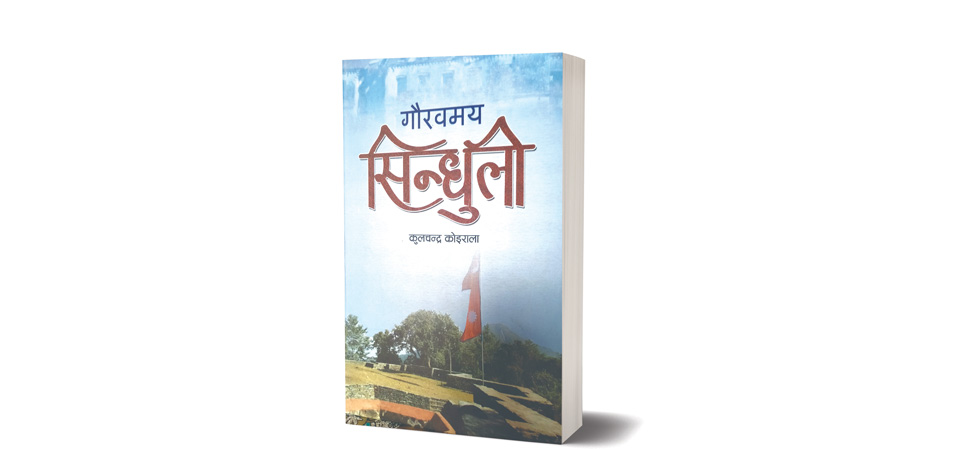Importance Of Sindhuli District

Gandhi Raj Kafle
The book under review, entitled, “Gaurabmaya Sindhuli” (Glorious Sindhuli) is a collection of essays on Sindhuli, one of the historically famous districts of Nepal. The author of the book is the late Kul Chandra Koirala, who has dozens of books already published to his credit on subjects of literature and culture.
Koirala, who himself was born in Sindhuli, had a multi-dimensional personality. Originally, with a background in Sanskrit study and speaking talents, he even performed Saptaha Puran. But, this was just one talent and ability. The next very important thing he made was his contributions to politics, especially during the time of revolution against the Rana regime. He even contested the historic national elections of 2015 BS as the Nepali Congress candidate from Sindhuli. The third talent with him (which is related to this under review book) was his deep fascination with Nepali literature and culture.
The new book "Gaurabmaya Sindhuli”, which is a posthumously published creation, offers an interesting reading to readers because it is made with the author's style of writing, which means we can find a description of social values, geographical beauty and cultural practises of glorious Sindhuli in literary flavour in this book. The other fact about the book is the author is not only careful but is also curious on matters of research while interpreting the historical importance of the district.
There are eighteen essays and two poems in this 197-page book. Sindhuli is not only the birthplace of the author, it is also a place from where he actively participated in politics carrying different political, social and religious activities. Thus, it is natural for author Koirala to have vivid knowledge about the district and he has been skillfully natural to utilise both observed and documented facts in his writing.
The author has proudly mentioned names like Badri Bikram Thapa, Babu Ram Baral, Katak Bahadur Thapa, Bishnu Prasad Dhungel and Chuda Raj Sharma Kafle who along with many other leaders championed the cause of the revolution for achieving democracy in the nation living there in Sindhuli and working from that part of the region in 1951 AD. The region, where Sindhuli, Ramechhap and Dolakha districts are situated today, was called the East Number Two in the administrative division of the Rana times. So, Koirala has appropriately described this whole part while writing about the glory of the Sindhuli in this book.
At a time when the country is vexed by the problem of corruption and bribery, the biographical description about the long time Badahakim (chief administrator) late Badri Bikram Thapa is inspiring. The author's first-hand information about Thapa’s clean administration while serving in the capacity of Badahakim is an inspiring thing even for today. Many political heroes are not only unsung but are also forgotten. But it is their contributions that always keep the flame of protest for justice burning. Koirala’s respectful portrayal in the book about Sindhuli personality Babu Ram Baral exposes this bitter fact.
Successes must not overshadow weaknesses and failures if we want to learn a lesson from past mistakes. It seems Koirala, as an author, is cautious about keeping balance in the description of counter-revolution which East Number two (Sindhuli-Ramechhap-Dolakha) faced in course of democratic struggles in 1951 AD.
In addition to national politics, the themes that figure in this book are many. Koirala has talked about Nepali literature and a brief introduction of prominent literateurs of this region, which he has presented here, is an interesting matter for literary researchers.
To readers of today, who love to switch on TV sets and open different social media on a mobile phone to enjoy information and entertainment, the author’s description of the social way of living in the past is insightful. In the last piece of writing entitled “Chandranigahpurko Chiththi” (A Letter of Chandranigahpur), he has emphasised how inquisitive, hard-working and studious one should be to derive a conclusion on matters of research. Today there is a kind of competition to prepare and publish genealogies of different Khash Brahmins and Chhetris. It is good, but author Koirala’s advice for genealogy makers to go to Karnali, Seti and Kali regions (which are the places of their origin) and wait patiently till the conclusive evidence is uncovered from the study should also be considered for quality research.
In a nutshell, what can be said is the book “Gaurabmaya Sindhuli" is not a book only about the Sindhuli district. It is also about the nation.
Recent News

Do not make expressions casting dout on election: EC
14 Apr, 2022
CM Bhatta says may New Year 2079 BS inspire positive thinking
14 Apr, 2022
Three new cases, 44 recoveries in 24 hours
14 Apr, 2022
689 climbers of 84 teams so far acquire permits for climbing various peaks this spring season
14 Apr, 2022
How the rising cost of living crisis is impacting Nepal
14 Apr, 2022
US military confirms an interstellar meteor collided with Earth
14 Apr, 2022
Valneva Covid vaccine approved for use in UK
14 Apr, 2022
Chair Prachanda highlights need of unity among Maoist, Communist forces
14 Apr, 2022
Ranbir Kapoor and Alia Bhatt: Bollywood toasts star couple on wedding
14 Apr, 2022
President Bhandari confers decorations (Photo Feature)
14 Apr, 2022










